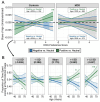Depression and emotion regulation strategy use moderate age-related attentional positivity bias
- PMID: 39737246
- PMCID: PMC11682907
- DOI: 10.3389/fpsyg.2024.1427480
Depression and emotion regulation strategy use moderate age-related attentional positivity bias
Abstract
Effective emotion regulation is critical for maintaining emotional health in the face of adverse events that accumulate over the lifespan. These abilities are thought to be generally maintained in older adults, accompanied by the emergence of attentional biases to positive information. Such age-related positivity biases, however, are not always reported and may be moderated by individual differences in affective vulnerabilities and competencies, such as those related to dispositional negative affect and emotion regulation styles. To examine these relationships, we analyzed eye-tracking data from 72 participants (35-74 years; 50 female), 44 without and 28 with a diagnosis of Major Depressive Disorder during a free-viewing task comprising neutral-neutral, negative-neutral, and positive-neutral image pairs. Emotional bias scores were calculated based on the ratio of time spent dwelling on the emotional image vs. the neutral image in each emotional-neutral pair. Results indicate that healthy participants exhibited a stronger positivity bias than a negativity bias, whereas individuals with higher depressive symptom scores showed no difference. Next, we examined how age and emotion regulation strategy use (reappraisal vs. suppression, measured with the Emotion Regulation Questionnaire) impacted these effects. Individuals with Major Depressive Disorder did not exhibit a significant relationship between age and positivity bias. However, for healthy participants who self-reported a preference for using reappraisal in daily life, increased age was associated with an increased positivity bias. These findings indicate that the emergence of the positivity effect in older adults is related to reappraisal regulatory preferences in the absence of depressive symptoms.
Keywords: aging; attentional bias; depression; emotion regulation; eye-tracking.
Copyright © 2024 Faul, Bellaiche, Madden, Smoski and LaBar.
Conflict of interest statement
The authors declare that the research was conducted in the absence of any commercial or financial relationships that could be construed as a potential conflict of interest.
Figures




References
LinkOut - more resources
Full Text Sources

